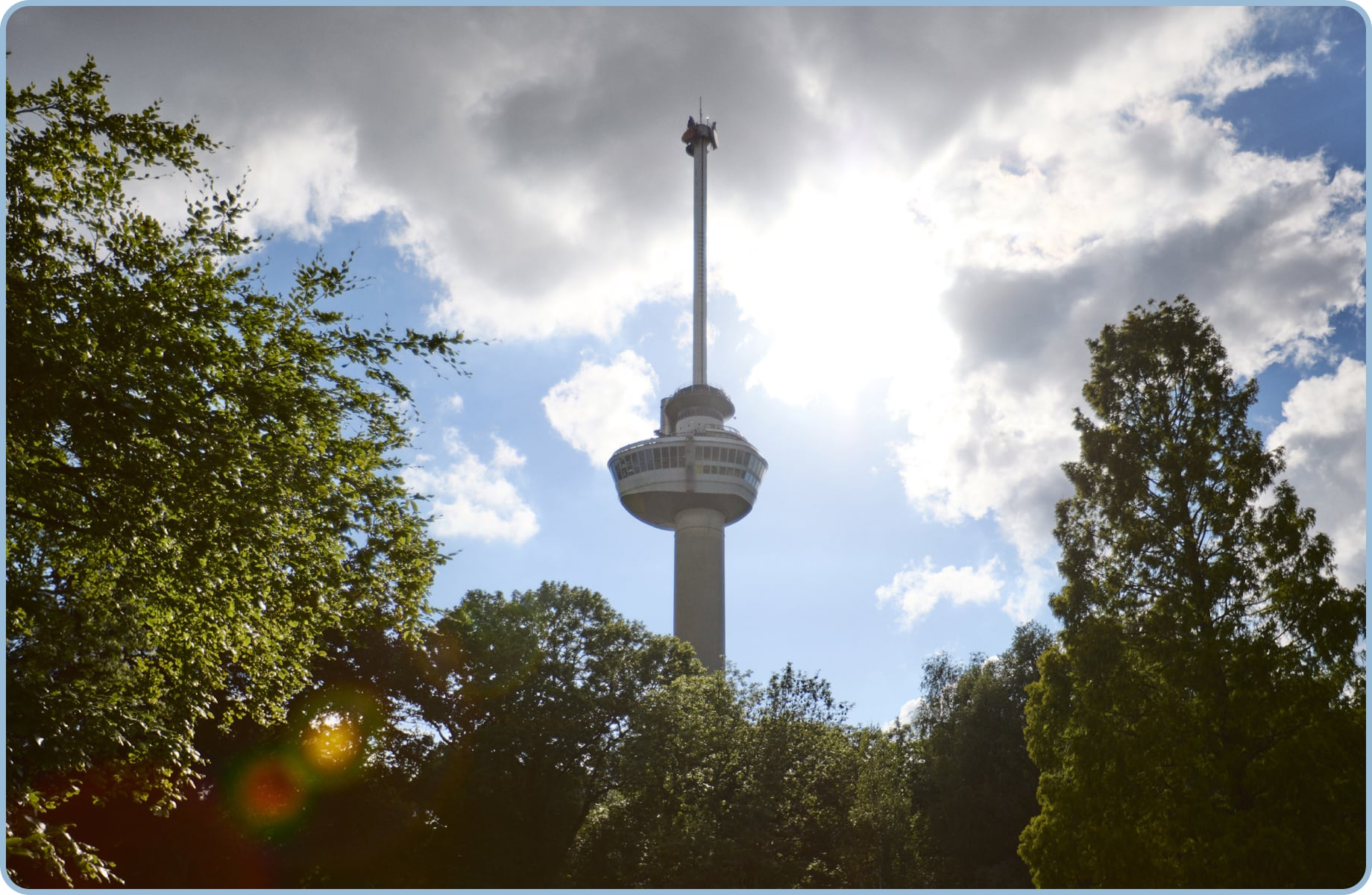
Euromast, since 1960
From Eurotower to Euromast
The first pole
A 100-meter ship mast with bridge and crow's nest
In the 100-meter-high crow's nest came two restaurants
Restaurant shook up in five days
2021
- Food and drink
- Enjoying the beautiful view of the city and Rotterdam's world port
- Abseiling
- Sleep
- & more!
Euromast Rotterdam
-
Euromast & het ss Rotterdam
-
Iconic highlight
More about the Euromast
Made of reinforced concrete, the tower has a diameter of 9 meters (inside) and a wall thickness of 30 centimeters. The foundation consists of 131 concrete piles. On this rests a 1,900,000-pound block of reinforced concrete, to counterbalance the above-ground structure. Thus, the center of gravity is below the ground for maximum stability. The crow’s nest is a 240,000-pound steel structure. The bottom hangs at 96 meters. It was built at the base of the mast and raised in 5 days. The ship’s bridge came to hang at 32 meters. The speed of the elevators is 4 meters per second. That means you get to 100 meters in 30 seconds.
On March 12, 1959, the Algemeen Dagblad called on its readers to guess when the Euromast would reach its highest point. By putting 50 cents worth of extra stamps on their postcards, participants would contribute to the Princess Beatrix Polio Fund. The action became a success. On March 26, at 2:59 p.m., a siren sounded over the docks; the first phase of construction was a fact. The action yielded the sum of fl. 67,000, = and the winners of the four main prizes could receive their respective car, scooter, TV set and washing machine.
In the 1960s, the Euromast was 100 meters high (excluding a 15-meter-high flagpole). Enough to tower above the skyline of the Maas city. But Rotterdam’s pride was overtaken left and right by other buildings. In 1970, the Euromast struck back. Eighty-five meters were added with the installation of the Space Tower. This made the Euromast the tallest building in Rotterdam again.
The Euromast was not Maaskant’s only contribution to the Rotterdam skyline. In the 1950s and 1960s, he left his mark on the city’s reconstruction. As early as 1949, he built the Zuidplein apartment building and, in the early 1950s, the Zuidwijk apartments. Later his office included the Groothandelsgebouw, the Hilton Hotel and the Lijnbaan flats. With the Euromast, he gave world port Rotterdam an eye-catching maritime monument.
For the first ten years, more than 6 million visitors came to enjoy the view. On fine days, they could see Antwerp, Moerdijk and The Hague in the distance. On less beautiful days, of course, Rotterdam in all its glory is beautiful too.
- In August 1962, 6 staff members were arrested on suspicion of ticket fraud.
- On April 25, 1964, the 2.5 millionth visitor to the Euromast was put in the limelight; Mrs. Groot from Aerdenhout was offered a bunch of flowers, lunch and a weekend in Rotterdam.
- A commercial radio station from Luxembourg broadcast a Sunday afternoon program from the Euromast in May 1964: Teener Topper Time. The reason for this location is symbolic: the European idea is propagated in this way. Stars such as Françoise Hardy, Adamo, Anneke Grönloh, Wil Tura and Ciska Peters are in attendance.
- In March 1964, the hostesses of the Euromast were given a uniform designed by Rotterdam couturier Cargelli. A golden yellow suit with black blouse and a hat in the shape of a round bonbon box.
- In September 1965, Feijenoord wins over Real Madrid and the red and white Feijenoord flag flies triumphantly on the Euromast.
- In 1970, the Euromast was raised to 185 meters with the arrival of the spacetower.
The Euromast was in danger of being wiped off the map in the 1990s by the ambitious Parkhaven Tower plan. A 392-meter-high tower by the London architectural firm Kohn Petersen Fox was to become Rotterdam’s new tourist attraction. As the largest building in Europe, it would have a residential, work and tourist function. Rotterdam’s city council eventually put a stop to it.

